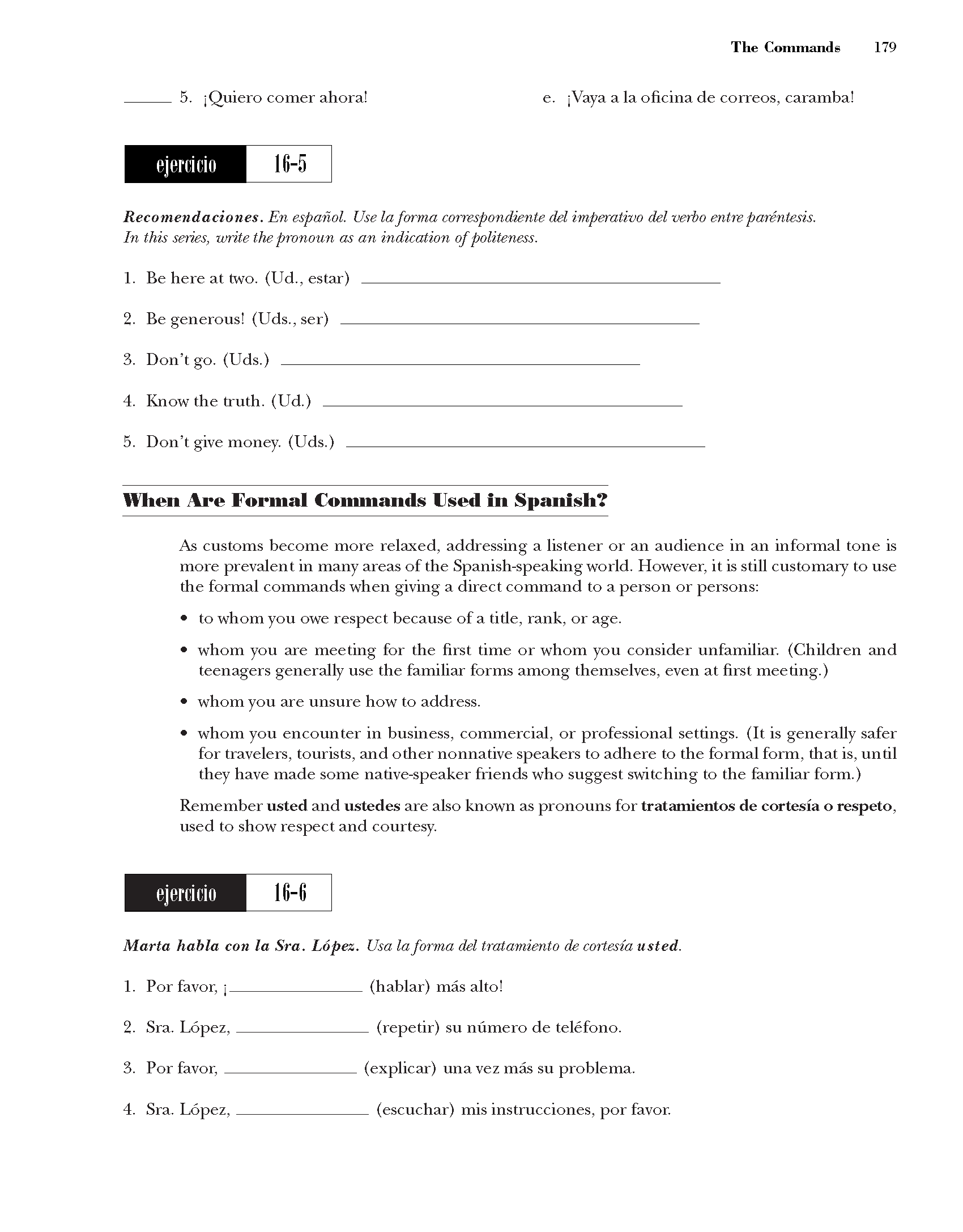CSG190

179
The Commands
5. jQuiero comer ahora! e. jYaya a la oficina de correos, caramba!
ejercicio
Recomendaciones. En espanol. Use la forma correspondiente del imperatwo del verbo entre parentesis. In this senes, write the pronoun as an indication of politeness.
1. Be here at two. (Ud., estar) _
2. Be generous! (Uds., ser) _
3. Don’t go. (Uds.) _
4. Know the truth. (Ud.) _
5. Don’t give money. (Uds.) _
Wlieii Aro Formal Coiiimamls llsocl in Spanisli?
As customs become morę relaxed, addressing a listener or an audience in an informal tonę is morę prevalent in many areas of the Spanish-speaking world. However, it is still customary to use the formal commands when giving a direct command to a person or persons:
• to whom you owe respect because of a title, rank, or age.
• whom you are meeting for the first time or whom you consider unfamiliar. (Children and teenagers generally use the familiar forms among themselves, even at first meeting.)
• whom you are unsure how to address.
• whom you encounter in business, commercial, or professional settings. (It is generally safer for travelers, tourists, and other nonnative speakers to adhere to the formal form, that is, until they have madę some native-speaker friends who suggest switching to the familiar form.)
Remember usted and ustedes are also known as pronouns for tratamientos de cortesia o respeto, used to show respect and courtesy.
16-6
ejercicio
Marta habla eon la Sra. López. Usa la forma del tratamiento de cortesia usted.
1. Por favor, \_ (hablar) mas alto!
2. Sra. López,_ (repetir) su numero de telefono.
3. Por favor,_ (explicar) una vez mas su problema.
4. Sra. López,_ (escuchar) mis instrucciones, por favor.
Wyszukiwarka
Podobne podstrony:
CSG190 179 The Commands 5. jQuiero comer ahora! e. jYaya a la oficina de correos,
Ziao i>> Wi op ip m ®j i B / L* K LęxlBoxIn the Beginning was the Command Linęhy Nea] Stephen
lnvoking MySQL Programs To invoke a MySQL program from the command linę (that is, from your shell or
Setting Environment Variables Environment variables can be set at the command prompt to affect the c
MySQL Proxy Command Options To start MySQL Proxy, you can run it directly from the command linę: she
05vel02 Tag Text command button. If False, the command button cannot receive the focus. Unused by Vi
CSG188 177 The Commands changes follows. For morę detailed study of verbs with spelling changes, rev
ConiniandLine Telnet Client The command linę version of Telnet is a Windows console program. To star
CSG007 VI Contents UNIT 16. The Commands 175 Formal or Polite Commands 176 Formal
CSG188 177 The Commands changes follows. For morę detailed study of verbs with spelling changes, rev
CSG192 The Commands 181 3. _ (venir) al gimnasio todos los dias. 4. &n
CSG194 The Commands 183 ser se tener ten venir ven ejercicio 16-12 l Cual es la palabra de
CSG196 The Commands 185 3. 4. (escuchar) los gritos de los fanaticos. (despertar) a T/uis, que est
więcej podobnych podstron